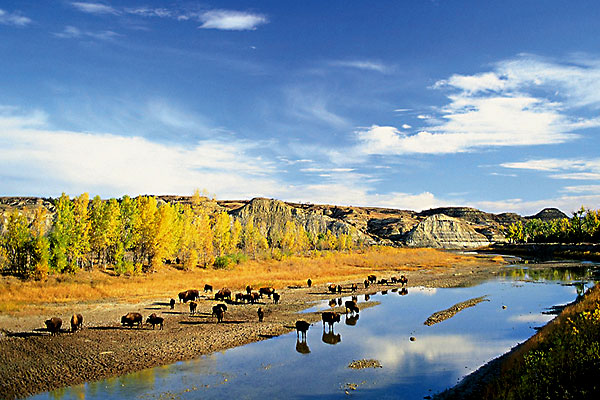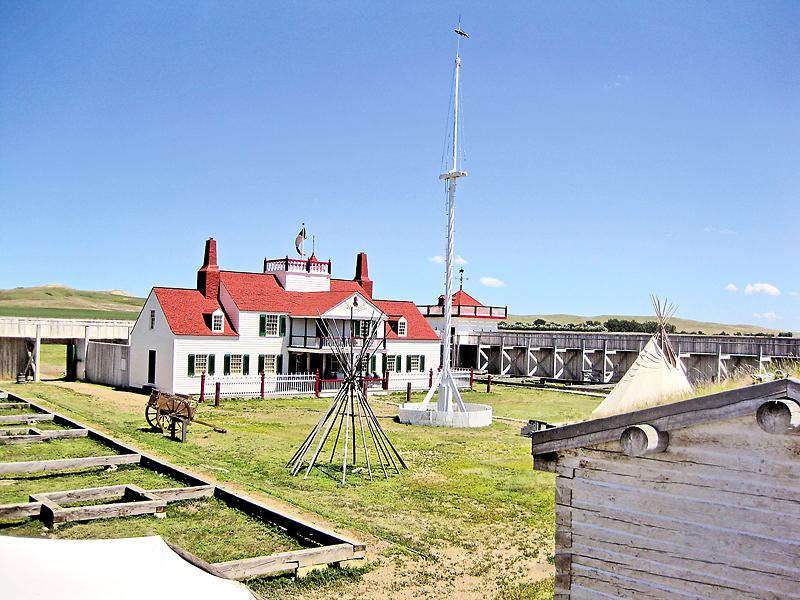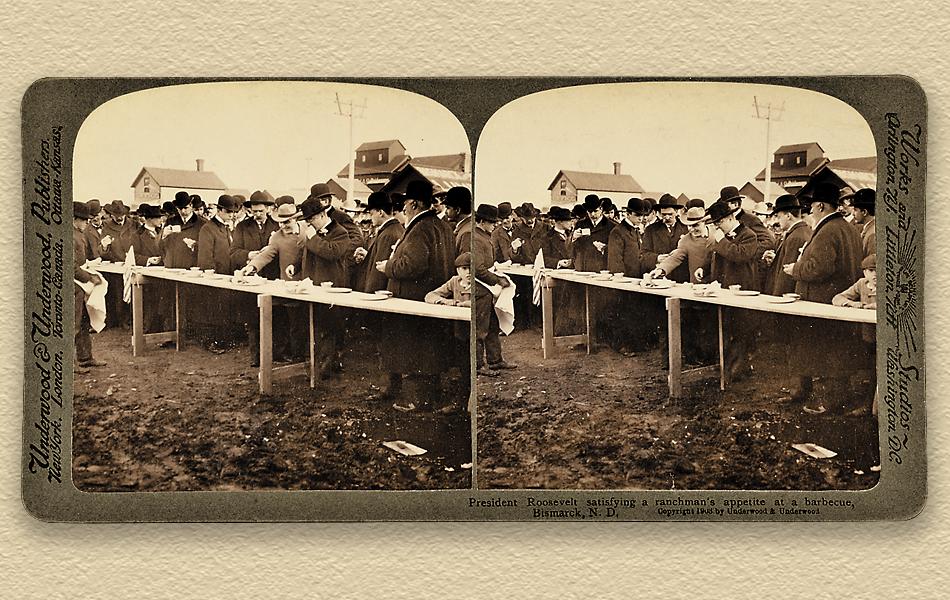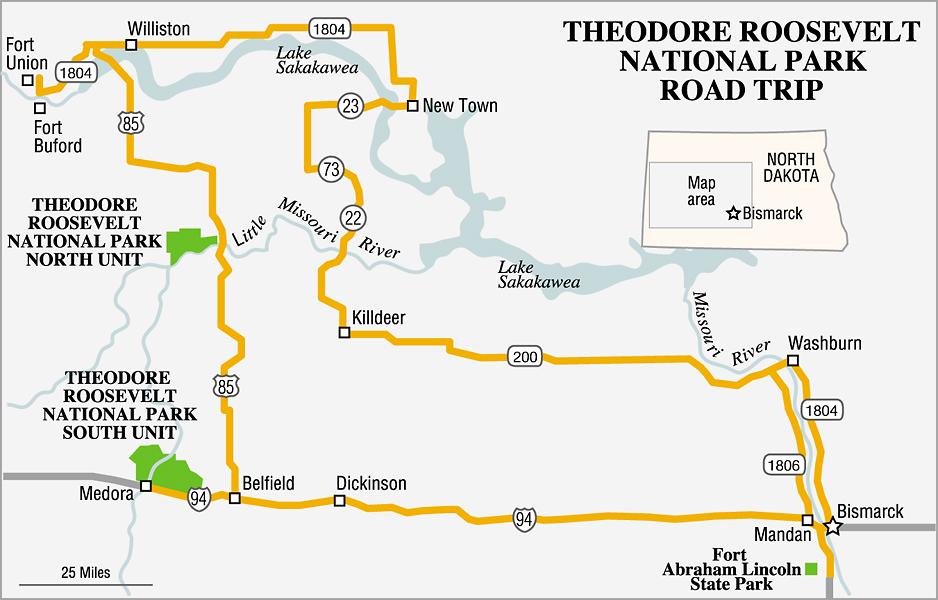 North Dakota is nicknamed the Roughrider State after Theodore Roosevelt’s 1st U.S. Volunteer Cavalry. TR (folks didn’t call him Teddy to his face) loved North Dakota. Tour western North Dakota, and you will understand why TR said if he were given the choice to remember only one aspect of his life, he would want to remember his adventures in Dakota Territory.
North Dakota is nicknamed the Roughrider State after Theodore Roosevelt’s 1st U.S. Volunteer Cavalry. TR (folks didn’t call him Teddy to his face) loved North Dakota. Tour western North Dakota, and you will understand why TR said if he were given the choice to remember only one aspect of his life, he would want to remember his adventures in Dakota Territory.
To reach the national park named in his honor, Theodore Roosevelt National Park, we will make a circle tour to and from Bismarck.
HIT THE ROAD IN BISMARCK
In 1873, the Northern Pacific Railway named the railhead that became North Dakota’s capital after Germany’s popular chancellor Otto von Bismarck, hoping to attract German settlers. Bismarck is situated on a free-flowing portion of the Missouri River, but upriver and downriver, the U.S. Army Corps of Engineers dammed the Missouri, creating immense reservoirs. The city has a treasure in the North Dakota Heritage Center, which is going to showcase even more Great Plains artifacts and exhibits when its expanded gallery reopens in the fall of 2014. Bismarck offers a wide variety of motels and dining. Locals rave about the buffalo dishes at Pirogue Grille, while train buffs will appreciate dining on Mexican fare at Fiesta Villa, inside the Northern Pacific depot rebuilt after an August 1898 fire. Make sure you call ahead for lodging as oil field workers and tourists can fill up rooms fast.
CUSTER’S LAST HOME
Driving west on Interstate 94, you cross the Missouri River and enter Mandan, heading south on Highway 1806. By the way, Highway 1804 on the Missouri’s left bank (looking downriver) is named for the year Lewis and Clark traveled upriver, while Highway 1806 on the right bank is named for the year they returned. After 10 miles, you will arrive at Fort Abraham Lincoln State Park where the fort has been reconstructed along with a replica Mandan Indian Village.
The military built Fort Abraham Lincoln in 1872 to protect the railroad and settlers. Lieutenant Col. George Armstrong Custer and the 7th Cavalry were stationed here; they left from this fort for what would become the Battle of the Little Big Horn in 1876. Cavalry and laundress re-enactors will guide you through the Custer House furnished the way George and Libbie would have furnished it. “Our slogan is ‘Where History Comes to Life,’ and we mean it,” says Tracy Potter, executive director of the Fort Abraham Lincoln Foundation. “We challenge our staff every year to live up to our reputation as presenting the finest living history on the Northern Plains, and they do.”
Just a short walk from the fort is the reconstructed Mandan Indian Village. Do not pass up entering one of the six earth lodges to experience what it might have been like to live in one.
DIGITIZING TR
Travel Interstate 94 west through rolling plains to Dickinson, which began as a railroad siding in 1880. In April 1886, Roosevelt captured and delivered three boat thieves to the town’s sheriff, and on Fourth of July that same year, TR gave one of his first great speeches in the town. “The Theodore Roosevelt Center at Dickinson State University is developing a central archive of Theodore Roosevelt documents,” says Project Manager Sharon Kilzer. “Our plan, in cooperation with the Library of Congress, Harvard University and other institutions with TR documents, is to unify these collections and make them accessible to the public online.”
The massive effort includes digitizing and indexing hundreds of thousands of Roosevelt documents and providing them in an easily searchable form. “You can read TR’s papers while wearing your slippers and bathrobe at your home computer,” Kilzer says. During your visit to Dickinson, she highly recommends the fine dining and unique atmosphere of the Brickhouse Grille.
DAKOTA BADLANDS
Continuing west on Interstate 94, you will begin to see views of Dakota Badlands. When Gen. Alfred Sully was pursuing Lakota and Dakota tribes in 1864, he called the Badlands, “Hell with the fires burned out.” The next town is Medora, where you should plan to make your base of operations for the next few days. Doug Ellison, Medora’s mayor, tells True West, “I like to say we are as close as people can come to time traveling back to the Old West.”
In 1883, a French cattleman and entrepreneur, the Marquis De Mores, started the town, naming it after his wife. Medora provides ready access to Theodore Roosevelt National Park’s South Unit. The North Dakota Cowboy Hall of Fame is one of my favorite stops as it is filled with priceless American Indian and pioneer relics. Medora offers lots to do, including the nightly Old West Medora Musical featuring historic, patriotic themes dedicated to TR and held at the outdoor Burning Hills Amphitheatre (this year’s shows run from June 7 to September 7). Plus, you will find plenty of places to stay and eat. Whenever I visit Medora, I enjoy topping off the day with a beer and buffalo burger at Boots Bar and Grill.
Mayor Ellison not only governs Medora, but he also owns the Western Edge Bookstore, so he knows quite a bit about TR. “The West had quite an impact on Theodore Roosevelt,” Mayor Ellison says. “Being from the upper class, he was kind of snobbish when he first came to Dakota.But when he began to ranch and he got down into the dirt, he grew to respect the working man. He found if you pull your own weight, you’re respected; if you don’t, you’re not.”
THE VISIONARY’S PARK
Theodore Roosevelt National Park is the only national park named after a person. “And rightly so,” says Eileen Andes, the park’s chief of Interpretation & Public Affairs. “Roosevelt as President set aside over 230 million acres of federal land for national forests, grasslands and wildlife preserves.”
The national park preserves more than 70,000 acres of Badlands. It’s divided into three units: North, South and, in between, the 218-acre Elkhorn Ranch, which was the location of TR’s second ranch. The park teems with wildlife and offers views of spectacular Badlands scenery. “Dakota Territory was important to the development of Roosevelt’s concept of conservation,” Andes says. “Roosevelt was a visionary. He saw the decline of the bison and elk herds here and the harmful effects of overgrazing, so he set out to reverse the trends.”
“Today’s visitors can see the same vistas Roosevelt saw,” Andes continues, “and maybe they will have some of the same transforming experiences.”
From Medora, backtrack east until you reach Belfield to take Highway 85 north. You will come to the Theodore Roosevelt National Park’s North Unit. This less-visited unit offers
rugged Badlands views and, if you’re lucky, glimpses of bighorn sheep. Normally I would tell folks to either set up camp here or push on, because of the lack of nearby motels, but folks now have the option of staying at the Watford Hotel, which opened up last summer in Watford City.
FRONTIER FORT TOURS
Continue north to Highway 1804 and take that west to Fort Buford, which was built in 1866 on the Missouri River. Here, in 1881, famous Lakota leader Sitting Bull surrendered.
Two miles upriver from Fort Buford, make reconstructed Fort Union your destination point. The American Fur Company established Fort Union in 1828. Under the direction of Kenneth McKenzie, “King of the Upper Missouri,” the fort became a trading and social hub. Many fur trade-era notables stopped here, including artists George Catlin and Karl Bodmer, and trapper Jim Bridger. Stroll across the fort’s parade ground and watch Indian and fur trader re-enactors bring the frontier fur trade world to life.
Backtrack on Highway 1804 to Williston, heart of North Dakota’s oil country. A combination of horizontal drilling and hydraulic fracturing has created an oil boom that has North Dakota ranking second to Texas in production. Kilzer recommends Gramma Sharon’s Family Restaurant for “great homemade soups and pies.” Ellison says the Trapper’s Kettle is a fun place to eat with “great mountain man decor.”
Continue east on Highway 1804 to New Town, administrative center for the Fort Berthold Reservation, home of the Mandan, Hidatsa and Arikara, also known as the Three Affiliated Tribes. In 1956, the U.S. Army Corps of Engineers built the Garrison Dam creating Lake Sakakawea on the Missouri River. Since the federal government effort flooded people’s homes, the government moved them to New Town in 1953. Be sure to cross Four Bears Bridge, over the Missouri River, named for a Mandan chief and a Hidatsa chief, both named Four Bears; the bridge is decorated with medallions that reflect the heritage of the Three Affiliated Tribes. My good friend Cheryl Stein, with the Frontier Army of the Dakota, an Indian Wars-period re-enactor group, enjoys eating at Scenic 23, east of New Town.
Next up, head to Killdeer, home of the Killdeer Mountain Roundup Rodeo, North Dakota’s oldest PRCA rodeo. The Buckskin Bar Steakhouse is a popular eatery in Killdeer. Eight miles northwest is the Killdeer Mountain Battlefield Historic Site, which commemorates the destructive battle on July 28, 1864, between Gen. Sully’s troops and a gathering of Lakota and Dakota Indians.
Washburn, home to the North Dakota Lewis and Clark Interpretive Center, is a must-see for any Lewis and Clark aficionado. The center also houses a complete set of Karl Bodmer prints. Nearby is a full-scale replica of Fort Mandan where Lewis and Clark’s Corps of Discovery wintered with the Mandan and Hidatsa tribes in 1804-05. Historical interpreters give demonstrations and tours of the fort. If you’re hungry, Stein recommends stopping at Dakota Farms Family Restaurant.
THE NEXT FRONTIER
Take the scenic route back to Bismarck, on either Highway 1804 or 1806 south. Back in Bismarck, end your trip with an Alien Burger and Outer Space Fries at Space Aliens Grill and Bar; you just might say, the meal is out of this world.
Photo Gallery
– By Bill Markley –
Bill Markley
– By Jim Hatzell –
– Courtesy Theodore Roosevelt National Park –
– By Cheryl Stein –
– By Bill Markley –
– Courtesy Library of Congress –













